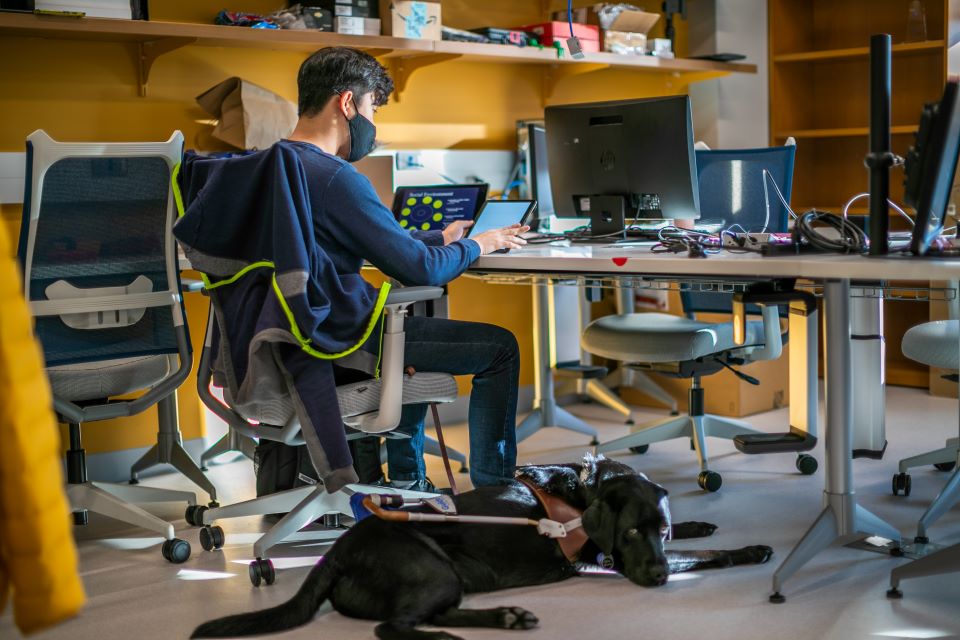SLU Student Instrumental in CHROME Lab Research
Bridjes O'Neil
Communications Specialist
bridjes.oneil@slu.edu
314-282-5007
Reserved for members of the media.
Seyoon Choi found math and science courses challenging in middle and high school – a time when he noticed a rapid deterioration of his vision.
“The photoreceptor cells along the back of my retina in the back of my eyes are damaged,” said Choi, a social work student in the College for Public Health and Social Justice (CPHSJ). “Anything that involved visual interpretation, like graphics and charts, was hard.”
There are varying degrees of visual impairments, with the most extreme being total blindness. Choi has a visual impairment. He is blind in his left eye and can recognize simple shapes and colors out of his right eye. His eyes work slower than most, and he has difficulty reading small font, he said.
In middle and high school, Choi had an aide who described images, wrote math problems out, and made braille copies of visual diagrams – an expensive and time-consuming process. In hindsight, Choi says he would have benefitted from digitally accessible content.
“I’m more of an auditory learner,” Choi said. “A device that interpreted graphics into audible and haptic form would have helped. It’s the best of both worlds, and it eliminates the need to spend time making physical braille copies, which takes considerable amounts of time.”
CHROME Lab Breaks Ground in Digital Accessibility
Jenna Gorlewicz, Ph.D., associate professor of mechanical engineering at SLU, and her team have developed a multimodal platform using touchscreen technology. Gorlewicz met Choi the summer before his senior year at Parkway Central High School. She was a guest speaker at Lighthouse for the Blind - St. Louis Summer Orientation & Mobility and Adapted Living Resources (SOAR) program.
Choi was a participant in SOAR, a three-week program that provides structured training and specialized instruction to 12 young adults ages 16 – 21 who are legally blind and intend to live independently, seek higher education or competitive employment.
After his admission to the University last year, Gorlewicz recruited Choi to join her research team in the Collaborative Haptics, Robotics, and Mechatronics (CHROME) Lab at SLU. The CHROME Lab is a place where engineers work collaboratively with professionals to create new technologies that augment human capabilities – not hinder them. In a world where humans are often required to "learn" technology, the CHROME Lab seeks to adopt human-centered design practices that result in technologies that feel natural and intuitive. Research applications span education, medicine, and consumer technologies.
Gorlewicz says Choi’s perspectives as an individual with visual impairments are unique and bring new insights to the lab’s research, particularly in elevating the touch channel in technology design.
“Seyoon is an incredibly bright individual. He’s an outstanding human, a quick learner, and he takes a true interest in learning new things,” Gorlewicz said of Choi. “Some of the challenges we’re tackling with the multimodal touchscreen work, including the creation of more complex graphics, have been driven by him and his personal experiences.”
Long before Choi arrived at SLU, he participated in some of the earliest touchscreen user studies run by the CHROME Lab. His feedback was critical in shaping the technology in its current form. Yet, there is still more to do, and both Choi and Gorlewicz are excited that he is now involved in the research and development of the technology.
Choi’s participation in the CHROME Lab doesn’t stop at the touchscreen project. He also works collaboratively with SLU graduate researcher Triston Cooper in the development of a hockey puck for blind ice hockey players. The project is supported by Lighthouse for the Blind - St. Louis in collaboration with St. Louis Blues Blind Hockey Club.
Gorlewicz’s research is funded through a 2019 NSF CAREER award. “Bridging the Digital Accessibility Gap in STEM Using Multisensory Haptic Platforms” targets K-12 education. The grant number is NSF 1845490.


















